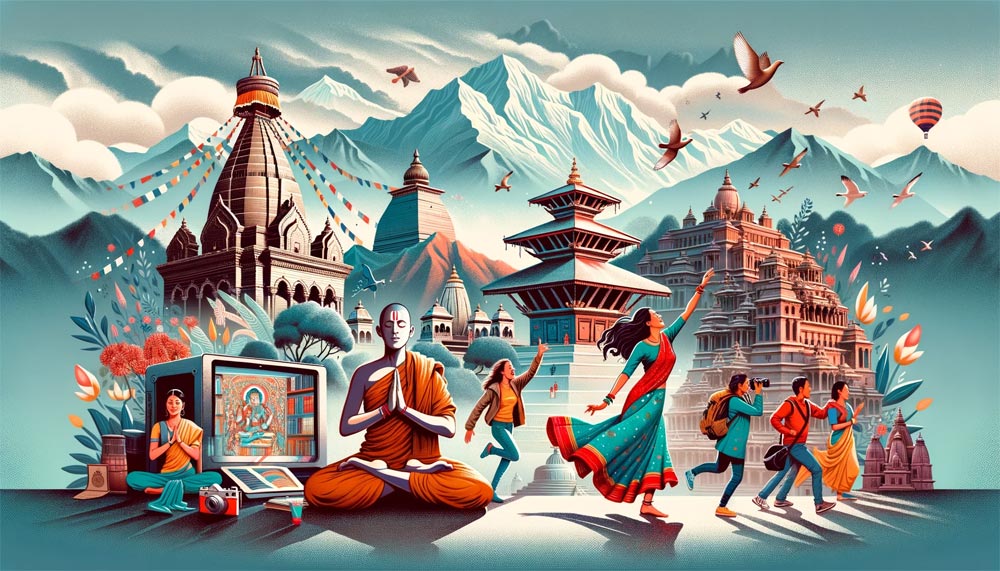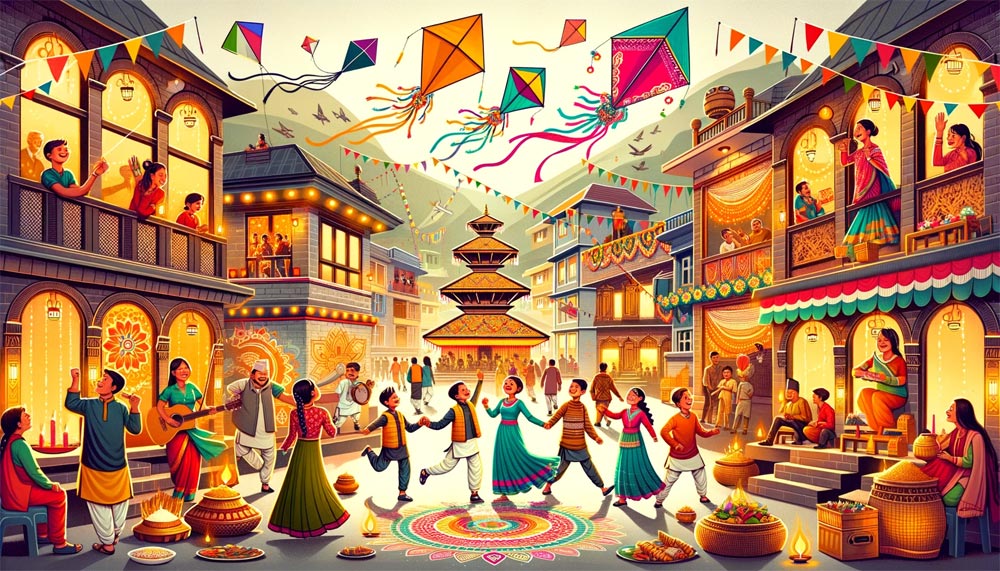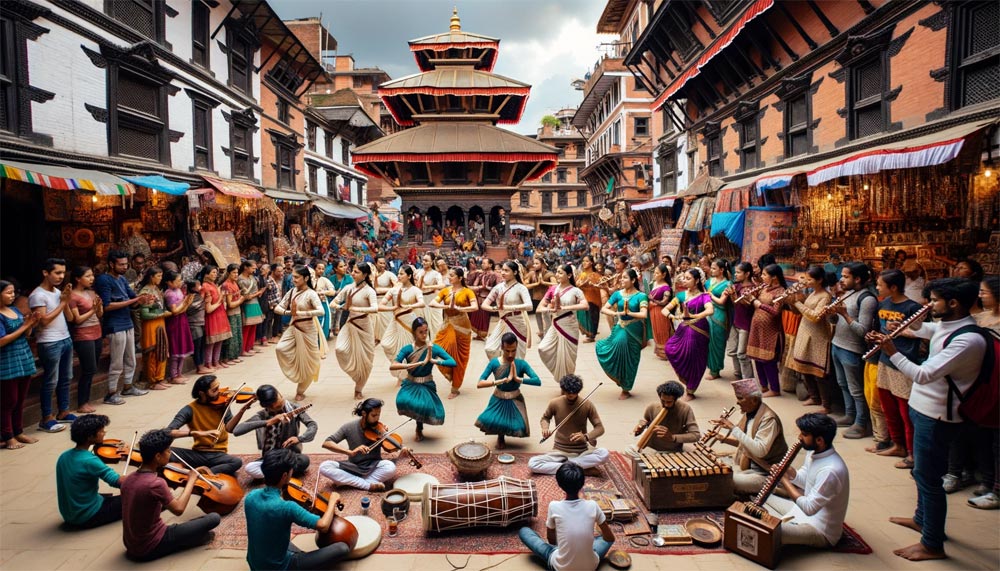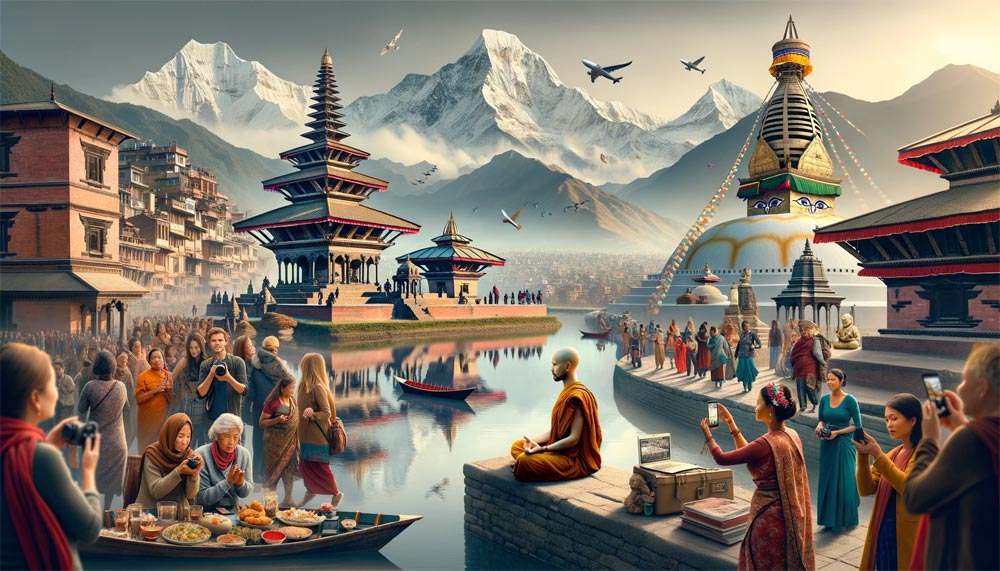
Nepal's Vibrant Culture: An In-Depth Exploration
Nestled amidst the majestic Himalayas, Nepal stands as a beacon of diverse cultural heritage, representing a tapestry of traditions, rituals, and festivals. This article delves into the culturally rich landscape of Nepal, illuminating its significance in the global context.
1. Overview of Nepal's Cultural Diversity
Nepal, a tiny Himalayan nation, stands tall when it comes to cultural richness. With its mosaic of ethnicities and languages, it offers a unique blend of traditions stemming from both Indo-Aryan and Tibetan ethnic groups.
-
Ethnicities and Languages: With over 120 ethnic groups, Nepal is a cauldron of diversity. While Nepali remains the official language, the country is home to more than 123 languages, each echoing tales of Nepal's diversified past.
-
Himalayan Culture and Kathmandu Heritage: The capital city, Kathmandu, is a reflection of Nepal’s history, housing numerous temples, palaces, and courtyards. The city's heritage echoes the larger Himalayan culture, making it a must-visit for cultural enthusiasts.
2. Nepal's Festive Prowess: Dashain, Tihar, and More
Nepal's festivals offer a vibrant insight into its profound cultural heritage. With festivities spreading across the calendar, Nepal presents a unique celebration every month, each echoing the nation's deep-rooted beliefs, folklore, and social fabric. Here's a closer look at some of the major festivals:

Dashain: Triumph of Good over Evil
Arguably the most significant and celebrated festival in Nepal, Dashain stands as a testament to the country's rich Hindu heritage.
- Significance: It commemorates the victory of the goddess Durga over the demon Mahishasura, symbolizing the triumph of good over evil.
- Observance: Dashain lasts for about 15 days, culminating in Tika, where elders bless the younger generation with vermilion, yogurt, and rice. Alongside, they gift money, emphasizing the importance of family reunions and intergenerational bonds.
Tihar: A Five-Day Homage to Nature and Animals
Often likened to the festival of Diwali in India, Tihar is celebrated with equal enthusiasm and reverence in Nepal.
- Significance: While it venerates the bond between Lord Krishna and the cow, the festival extends its homage to various animals, acknowledging their importance in human lives.
- Observance: Over five days, crows, dogs, cows, oxen, and horses are honored and garlanded. Homes are illuminated with oil lamps and decorated with colorful rangoli artworks.
Teej: A Day of Fasting and Felicity
Teej is an exclusive women's festival, marked by vibrant processions, songs, dances, and an air of fervor.
- Significance: It celebrates the reunion of Lord Shiva and Goddess Parvati, symbolizing marital bliss and fidelity.
- Observance: Women, clad in red saris (indicative of marriage), fast for their husbands' longevity. Even unmarried girls partake, praying for ideal life partners. Amidst fasting, women sing, dance, and immerse themselves in Teej tales.
Holi: The Festival of Colors
An emblem of unity, joy, and the victory of good over evil, Holi is celebrated with unmatched zest in Nepal.
- Significance: It marks the demise of Holika, signifying the triumph of good over malevolent forces.
- Observance: People drench each other in colored waters, throw vibrant powders, and relish special dishes. Folk songs, dances, and community gatherings are essential features.
Indra Jatra: Honoring the Rain God
Kathmandu's historic Durbar Square comes alive during Indra Jatra, an eight-day festival honoring Indra, the god of rain.
- Significance: It's a gratitude gesture towards Indra for the rains and the subsequent harvest.
- Observance: The festival witnesses various classical dances, including the famous "Kumari Jatra," where a chariot carrying the living goddess Kumari is paraded through the city.
Quotes:
"Festivals in Nepal are as number as there are days in a year." - Sudha Shrestha, a cultural researcher from Kathmandu.
Example: A notable feature during Tihar is the 'Bhailo' and 'Deusi' performances, where groups go house-to-house singing and dancing, reminiscent of carol singing during Christmas.
Case Study: In 2019, the Nepal Tourism Board initiated the "Experience Local Festivals" campaign. Tourists were paired with local families to celebrate Dashain and Tihar, fostering cultural exchanges. The overwhelming positive feedback emphasized the allure of Nepal's festive traditions for global travelers.
To truly appreciate the cultural heritage of Nepal, immersing oneself in its festivals is crucial. Each festivity offers a blend of spirituality, history, and social customs, making Nepal's festive prowess unmatched in the global panorama.
3. Rhythms of Nepal: Traditional Dances, Music, and Arts
The cultural essence of Nepal is deeply reflected in its music, dances, and traditional art forms. From the reverberating beats of the madal (a traditional drum) to the intricate strokes of Thangka paintings, the artistic expressions of Nepal resonate with tales of its rich history, folklore, and societal evolution.

Traditional Music: Echoes of the Himalayas
Nepal's musical landscape is as diverse as its topography. Each region, each community, boasts its unique style, rendering a kaleidoscope of sounds.
-
Classical Music: Rooted in age-old traditions, Nepali classical music often intertwines with rituals, making it an integral part of ceremonies and religious practices.
-
Folk Music: This genre truly captures the essence of Nepal's diversity. With songs narrating tales of love, bravery, and everyday life, folk music varies from the pastoral tunes of the Terai plains to the haunting melodies of the high Himalayas.
Dances: Narratives in Motion
Beyond mere performances, dances in Nepal serve as a reflection of its societal fabric, religious beliefs, and historical tales.
-
Lakhe Dance: Often observed during the Indra Jatra festival, this dance features a demonic character, Lakhe, representing a carnivorous demon from Nepali folklore.
-
Tamang Selo: A vibrant dance reflecting the life and culture of the Tamang community. The rhythmic beats of the damphu (a hand drum) guide the dancers' swift movements.
-
Tharu Stick Dance: Originating from the Tharu community of the Terai region, this dance is characterized by dancers wielding sticks, enacting agricultural activities to rhythmic beats.
Arts: Canvas of Spiritual & Historical Narratives
The artistry of Nepal is vast, encompassing various mediums, each echoing Nepal's spiritual inclinations and historical richness.
-
Thangka Paintings: These intricate scroll paintings, often on cotton or silk, depict Buddhist deities and are used as meditation tools. Their vibrant colors and meticulous details make them sought-after pieces worldwide.
-
Wooden Crafts: Woodwork, especially seen in the ornate windows and doors of temples and palaces, reflects the expertise of Nepali artisans. Kathmandu Valley, in particular, is renowned for its exquisite wood carvings.
-
Terracotta Artifacts: Often seen in temples and local homes, these clay works, whether in the form of deities or decorative pieces, have a rustic charm, showcasing the age-old pottery skills of Nepal.
Quotes:
"Art and culture in Nepal are not mere expressions; they are lifelines connecting past, present, and future." - Dr. Laxman Shrestha, a renowned Nepali artist.
Example: In Bhaktapur, during the Bisket Jatra festival, traditional Newari music forms the backdrop for chariot races, illustrating how deeply music is embedded in local festivals.
4. Historical Landmarks and UNESCO Sites: A Testament to Nepal’s Legacy
Nestled amidst the towering peaks of the Himalayas, Nepal isn't just a geographical wonder but also a repository of ancient history. Peppered across its landscape are historical landmarks and UNESCO World Heritage Sites that echo tales of dynasties, spiritual journeys, and architectural brilliance.

Kathmandu Valley: The Cultural Epicenter
The Kathmandu Valley, enveloping the capital city and its peripheries, is home to seven UNESCO World Heritage Sites, each a testament to Nepal's architectural and cultural grandeur.
-
Swayambhunath (Monkey Temple): Perched atop a hill, this stupa is one of the oldest religious sites in Nepal. The omnipresent eyes of Buddha, painted on the stupa, watch over the valley, symbolizing his all-seeing nature.
-
Pashupatinath Temple: Dedicated to Lord Shiva, it's a significant pilgrimage site for Hindus. Situated on the banks of the Bagmati River, the temple complex witnesses daily rituals, cremation ceremonies, and the annual Shivaratri festival.
-
Patan Durbar Square: Once the royal palace of the Malla kings, it's now a vibrant nexus of art, with its courtyards, pagoda-style temples, and intricate wood carvings.
Lumbini: The Birthplace of Buddha
An emblem of peace and spirituality, Lumbini stands as a beacon for Buddhists worldwide.
-
Significance: Recognized as the birthplace of Siddhartha Gautama, who became Buddha, Lumbini is adorned with monasteries, stupas, and the sacred Bodhi tree.
-
The Ashoka Pillar: Erected by Emperor Ashoka in 249 BC, it verifies Lumbini as the Buddha's birthplace and epitomizes the Mauryan Empire's endorsement of Buddhism.
Sagarmatha National Park: Nature's Heritage
While Nepal's heritage is often equated with its cultural and religious landmarks, Sagarmatha National Park, with Mount Everest at its heart, is a natural UNESCO World Heritage site.
- Flora and Fauna: Home to the snow leopard, red panda, and myriad bird species, the park is a biodiversity hotspot. Its pristine forests of pine and hemlock add to its ecological significance.
Chitwan National Park: A Bio-reserve Marvel
Situated in the Terai plains, Chitwan is a haven for wildlife enthusiasts.
- Wildlife: From the one-horned rhinoceros to the Bengal tiger, Chitwan's rich biodiversity makes it a must-visit for nature lovers.
Quotes:
"Nepal, in its monuments and mountains, embodies a confluence of nature's grandeur and human endeavor." - Prof. Bimala Tumkhewa, Historian.
Example: In Bhaktapur Durbar Square, the 55-Window Palace stands as a testimony to the architectural finesse of the Malla dynasty, with its ornate woodwork and intricate latticework.
5. Religious Practices and Spiritual Beliefs
The essence of Nepal is woven intricately with threads of faith and spirituality. Home to a myriad of religious practices, Nepal stands as a testament to religious tolerance and syncretism. From the melodic chants of Buddhist monks to the ceremonial rituals of Hindus, the spiritual journey of Nepal offers a rich tapestry of traditions and beliefs.
Hinduism: The Dominant Faith
Hinduism, being the predominant religion, profoundly influences the socio-cultural framework of Nepal.
-
Temples and Shrines: From the revered Pashupatinath Temple to the sacred Muktinath, Nepal's landscape is dotted with temples, each narrating tales of gods, goddesses, and ancient rituals.
-
Festivals: Celebrations like Dashain, symbolizing the victory of good over evil, and Teej, a women-centric festival, are deeply entrenched in Hindu mythologies and are celebrated with zest across the country.
Buddhism: Legacy of the Enlightened One
Tracing its roots to Lumbini, the birthplace of Buddha, Buddhism in Nepal is characterized by monasteries, stupas, and serene chants.
-
Stupas and Gompas: Boudhanath and Swayambhunath stupas are emblematic of Nepal's Buddhist heritage. Monasteries or 'Gompas' further resonate with teachings of compassion and non-violence.
-
Mantras and Prayer Flags: The ubiquitous prayer flags fluttering in the Himalayan breeze carry mantras and prayers, spreading goodwill and positive energy.
Indigenous Beliefs: Echoes of the Ancestors
Beyond the major religions, Nepal is home to indigenous communities with their unique spiritual practices.
-
Shamanism: Predominantly among the Tamang and Rai communities, shamans or 'Dhamis' play pivotal roles, acting as intermediaries between the physical and spiritual realms.
-
Nature Worship: Many ethnic groups venerate nature, with rituals dedicated to mountains, rivers, and forests, underscoring the harmonious coexistence of man and nature.
Quotes:
"In Nepal, every stone, every river, and every mountain has a story, a deity, and a ritual associated with it." - Anuradha Koirala, a noted Nepali social activist.
6. Nepal’s Culture in Today's Global Context
In an increasingly globalized world, cultures intermingle, and boundaries blur. Yet, Nepal's rich tapestry of traditions, arts, and spiritual practices continues to shine, finding relevance and resonance in today's cosmopolitan milieu.
Cultural Export: From Himalayas to the World
Nepal, while preserving its ancient traditions, has seamlessly integrated its cultural offerings into the global arena.
-
Yoga and Meditation: Originally rooted in the spiritual practices of the region, Nepal's yoga and meditation retreats are now sought after by global enthusiasts seeking solace and self-realization.
-
Handicrafts and Art: Nepalese handicrafts, especially pashmina shawls, thangka paintings, and intricately carved wooden artifacts, have found admirers and markets worldwide.
-
Cuisine: Nepalese cuisine, with its delectable momos, thukpa, and gundruk, has tantalized global taste buds, with Nepali restaurants proliferating in major cities across the world.
Cultural Diplomacy: Strengthening Bonds
Nepal's cultural heritage has played a pivotal role in its diplomatic endeavors, fostering relationships and mutual respect.
-
Cultural Festivals Abroad: Events like "Nepal Day" in countries like the USA, UK, and Australia not only promote Nepal's culture but also strengthen ties with the Nepali diaspora.
-
Educational and Cultural Exchange: Nepal's collaborations with global universities and cultural institutions have paved the way for exchange programs, research, and mutual appreciation.
Preservation in the Age of Modernity
In an era dominated by technology and rapid change, Nepal grapples with preserving its cultural identity while embracing modernity.
-
Digital Archives: Efforts are being made to document and digitize ancient manuscripts, folk songs, and traditional dances, ensuring they are passed on to future generations.
-
Sustainable Tourism: Emphasizing eco-friendly and culturally respectful tourism, Nepal ensures that its heritage sites and traditions are not diluted but celebrated responsibly.
Quotes:
"Nepal stands as a beacon, showcasing how ancient traditions can not only coexist but flourish in the contemporary world." - Dr. Ram Baran Yadav, former President of Nepal.
Example: The annual "Himalayan Film Festival" held in San Francisco showcases films from and about the Himalayan regions, celebrating the culture, spirit, and challenges of the people of Nepal and its neighboring regions.
Conclusion
Nepal, though geographically small, is a giant in terms of cultural heritage. From its festivals and rituals to its art and history, it offers a myriad of experiences for travel enthusiasts, cultural researchers, and general readers alike.
"Nepal is a world in itself; a world of diversity, culture, and traditions, waiting to be explored." - Excerpt from "Culture of Nepal" by Madan Puraskar Pustakalaya.
To truly fathom the depth of Nepal's culture, one needs to immerse oneself in its festivals, arts, and traditions. The tales of its grandeur, as preserved in its heritage sites, music, and dance, promise a journey like no other.
For a more exhaustive exploration, readers are encouraged to peruse official publications by the Nepal Tourism Board, delve into UNESCO’s documentation on Nepalese heritage sites, and explore local journals that shed light on this Himalayan gem.
Nepal Related Topics Culture




